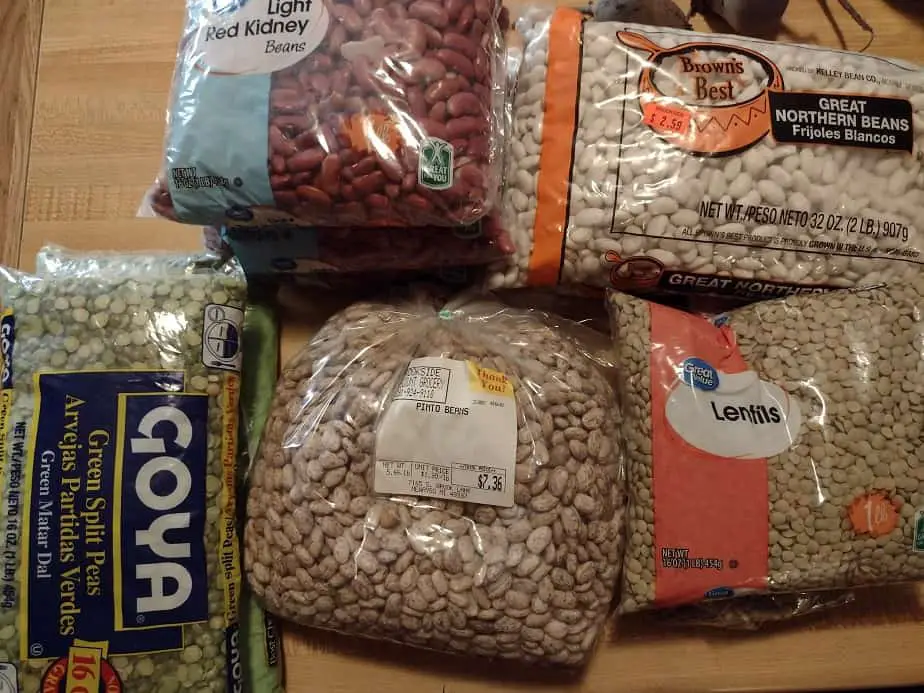We have a 6-month supply of food on hand. It’s good to know that if stores go empty, my family will eat. Here are 20 great storage food options that we have put up for long-term storage.
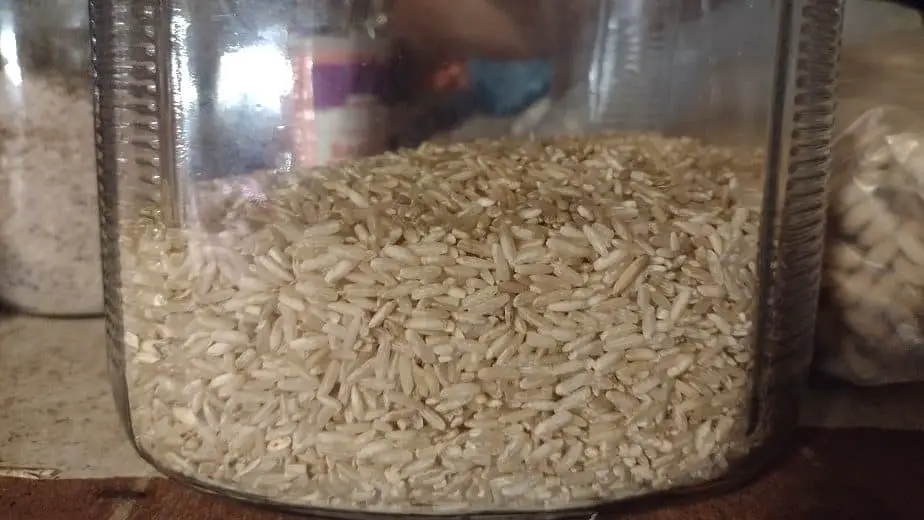
Rice
Rice is the most common food item in the world. It’s high-calorie, has moderate amounts of protein, and is definitely shelf-stable. Rice is one of the foods that are said to have an indefinite shelf life under the proper storage conditions. It’s also fairly cheap to buy. We have a lot of dry rice.
Dry rice is known for having bug problems, as are all grains. You need to be sure it’s stored in a container that bugs can’t get into. The plastic bag most rice comes in won’t do. those bags are very thin and get holes in them easily. Store those bags of rice in something sturdy like a 5-gallon bucket.
Brown rice, or wild rice, is a better option than white rice. White rice, even though it has added vitamins, has a lower nutritional value than Brown rice. It has more fiber, protein, and significantly more vitamins. It also contains natural oils that are removed in white rice.
Some say that the oil lessens its shelf-life because oil can oxidize and break down, going rancid. The truth is, proper storage will completely prevent that. Even if rice does oxidize, that just means it’s gone stale and will have a different taste and texture, and a smidge fewer calories. It’s still fine for eating.
Approximate of dry white rice
- Calories 720
- Fiber 2g
- Protein 13g
- Also a decent amount of iron and a smidge of potassium.
Approximate nutrition in a cup of brown rice
- Calories 680
- Fiber 7g
- Protein 15g
Brown rice is higher in sodium, potassium, and iron than white rice. Learn how to store rice long term with this article: How to Store Rice Long Term (and how much per person)
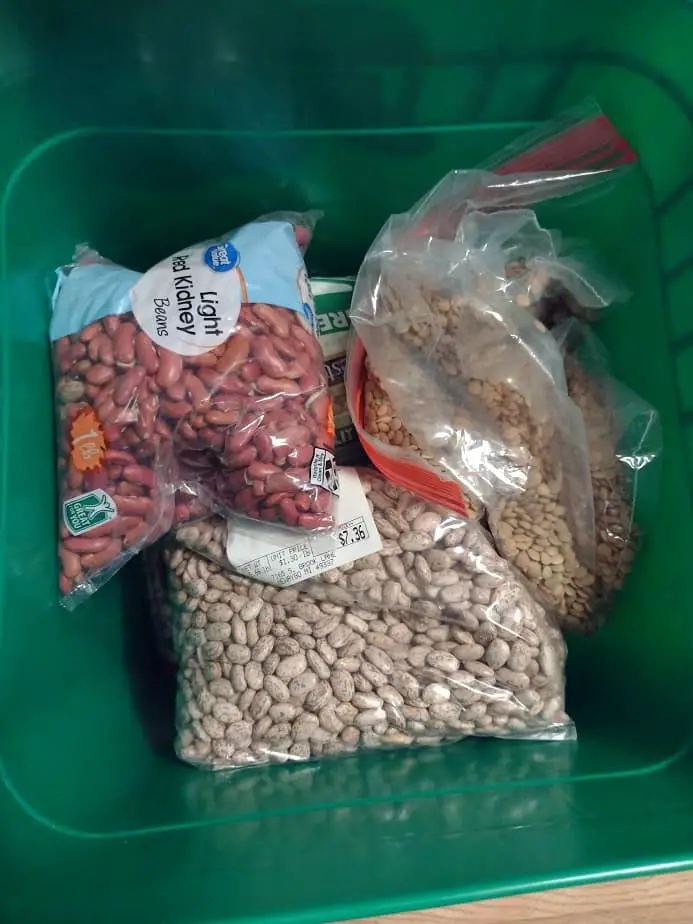
Beans
Beans are the most shelf-stable source of complete protein. About 40 percent of the calories in beans come from protein and they have all the proteins we need to stay healthy. Apart from meat, there is no other source of protein that will adequately meet all your dietary needs.
Beans also have a max shelf life pushing towards indefinite when stored properly. In fact, all gains do. Since beans are a seed, I halfway consider them a grain. Beans also contain decent amounts of fiber and more than your daily needs of Thiamine and vitamin B1. A lack of Thiamine causes neurological problems.
Not all beans have the same mix of proteins. It’s best to have several types of beans to help balance out the protein levels even more. Adding as much variety to a diet as you can help people stay healthy during a situation that could be rather serious.
Approximate Nutrition in a cup of dry beans
- Calories 650
- Carbohydrate 120g
- Fiber 30 g
- Protein 43 g
Beans are also very high in Magnesium, Iron, Vitamin B1, and Vitamin B6. It also has decent levels of calcium believe it or not.
An adult is supposed to have at least 50 grams of protein and about 2,000 calories per day. One cup of dry beans is almost a full days worth of protein. Two cups of dry brown rice and a cup of dry beans is quite near a complete-ish diet for an adult. Beans have lots of fiber.
That’s about 2,000 calories, 70 grams of protein, a little fat, plenty of fiber, and some good vitamins. Off to a good start anyways. There’s a good reason why almost half the world is sustained mainly by beans and rice. It’s a solid foundation for a complete diet.
Here’s a link to an article on storing beans. How to Store Beans Long Term
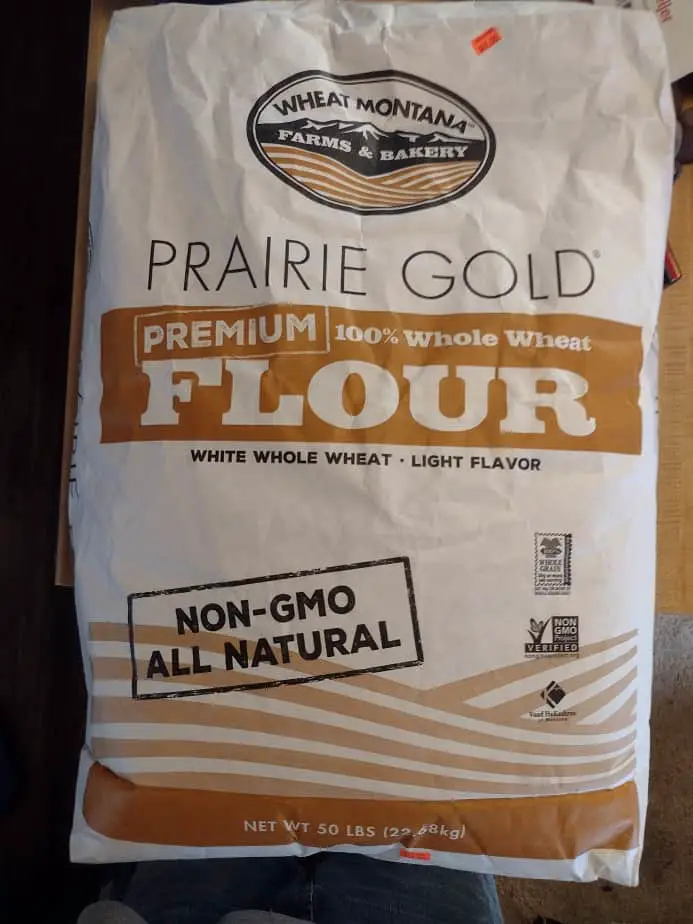
Flour
Flour is the most versatile long-term storage food item. You can eat it raw or cook it into biscuits, bread, gravy, dumplings, or anything else you can think of. During the exploration days of America, soldiers and those working for the fur companies were often given a daily ration of flour, between 2 and 4 cups worth.
Approximate nutrition in a cup of all-purpose flour
- Calories 450
- Fiber 3.4g
- Protein 13g
- Not a lot else
Approximate nutrition in a cup of whole wheat flour
- Calories 400
- Fiber 13g
- Protein 16g
Whole wheat flour has 3 to 4 times the amounts of iron, B6, Magnesium, and Calcium than white flour. That’s why it’s the only flour I prefer to stock on. It also happens to be the only flour my wife will cook with. We have a lot of whole wheat flour. It’s lower on calories because it has all the fiber with it still.
Do understand that white, all-purpose flour is quite a bit cheaper than whole wheat, so you may decide to go with it anyways. I don’t really recommend that, but do what you can. As long as it’s stored well, flour will keep for 20-30 years quite easily. Also, white flour is very low in fiber.
Here’s an article I wrote on storing flour. How to Store 50 Pounds of Flour

Sugar
Sugar is the simplest food item to store because it can’t go bad unless it gets really wet and ferments. Supposedly, sugar can last forever if it’s kept away from pests and not submerged in water. Around here, It will only last if I keep the kids out of It. I have around 40 pounds of white sugar in the pantry.
White sugar is nothing but carbs and calories, nothing else. Nutritionally, it’s a horrible food because it’s full of calories like beans and grains are, but has nothing else in it. A 2,000-calorie diet of white sugar, about 2 1/2 cups, would quickly starve your body through malnutrition. 1 cup is about 775 calories.
It’s not even that much higher in calories than rice or beans. The only reason I like it for long-term storage food is that it can’t go bad. you can keep it in the original paper bag and in 50 years, if the mice stayed out, it’s still good as new. The chemical bond in sugar doesn’t weaken with age.
It can be a good option to boost up both the flavor and caloric value of an otherwise flat and unfilling dish. You can put a little sugar in pretty much any dish and it will improve the flavor. Raw or unrefined sugars have more nutrition, but that will diminish with time unless stored very well.
Lentils
Lentils are a little higher in protein than beans and less fiber, but about the same calories. I consider Lentils to basically be in the same category as beans because they are so nutritionally similar. Lentils will keep for a long time and store just the same as dry beans, 20+ years with ease.
The key with lentils is that I use them to have a more balanced set of proteins. I like to have a few different beans and some lentils as a protein source. None of them have quite the “perfect” balance of proteins as meats do, but having a little variety fixes that pretty well. Lentils cook easier than beans
Approximate nutrition in a cup of dry lentils
- Calories 675
- Fiber 20g
- Protein 48g
Lentils are high in iron and potassium, high in fiber, and have some Vitamin C and a little bit of calcium.
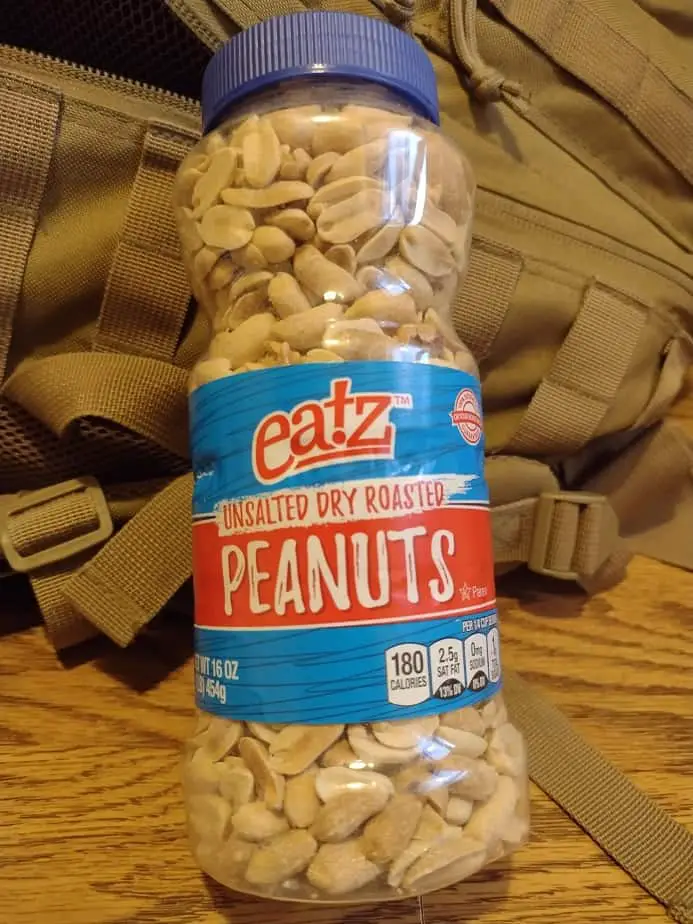
Peanuts
Peanuts are one item a lot of people overlook. They are fairly cheap, full of protein and fat, and store decently. Their high-fat content causes them to be more susceptible to oxidation, losing nutrition and flavor with age unless packed in an oxygen-free environment.
The good ole’ mylar bags with oxygen absorbers will keep peanuts good for as long as anything can be, probably. The science says at least 20 years. The great thing about peanuts is that they’re fine to eat as is. eating beans or peas uncooked causes gastrointestinal issues (major gas) due to tannic acid.
Dry, roasted peanuts taste great, especially compared to uncooked beans and rice. You don’t have to cook them, just eat as is. Beans are very high-calorie, high fat, and pretty high in protein. They don’t really have much vitamin content, but not much here does yet. That’s more a fruits and veggies thing.
Dried beans, peas, and lentils all have around 2-3 grams of fat per cup. That’s not even enough to mention. Peanuts are a whole different story. I have I think, 10 gallons of peanuts sealed up in buckets.
Approximate nutrition of a cup of shelled, roasted peanuts
- Calories 850
- Fiber 11g
- Protein 35g
- Fats 72g
Dry Peas
Peas are the last of the plant protein foods. They are high protein, high calorie, and high in potassium and iron, just like beans and lentils. Peas do have significantly more fiber, and a bit more sugar. Besides that, they are a super source of protein and calories. Peas have a ton of fiber, go lightly with them.
Add peas to you food stores to help balance out your protein sources. They will store for 20 years very easily, and much longer if sealed in mylar with oxygen absorbers.
Approximate nutrition in a cup of dry peas
- Calories 700
- Fiber 50g
- Protein 47g

Oats
Oats, specifically oatmeal or rolled oats are something we have a lot of. My kids love their oatmeal for breakfast and we rotate through it fairly quickly. Oats are a great long-term storage food. They are high in fiber, have a good calorie count, and are high in calcium, iron B6, and magnesium.
Approximate nutrition in a cup of dry oats
- Calories 230
- Fiber 9g
- Protein 12g
Barley
Barley is similar to oats and stores exceptionally well. It has a little fewer calories and protein and has about 50 percent more fiber. It also has a lower glycemic index which may make it a better choice for people with blood sugar issues.
I landed 100 pounds of rolled barley at a great price over the winter. My kids eat it thinking it’s Oatmeal. I will let you know that barley has a lot of gluten, so it may trigger people with gluten allergies or intolerance.
Approximate nutrition of a cup of rolled barley
- Calories 280
- Fiber 14g
- Protein 109g
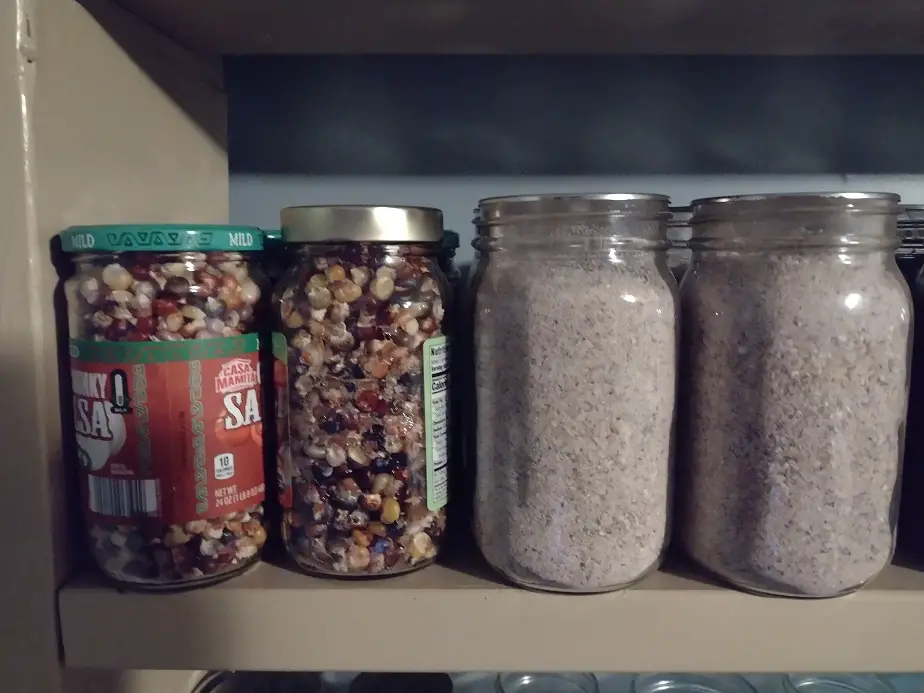
Whole Corn
Whole corn is my favorite grain to store and to eat. Besides being a cheap whole grain, corn is very nutritious and keeps for a long time quite easily. All grains will last longer if they are left intact, not ground, rolled, or cracked. But, they take longer to cook unless you crack or grind them open.
Whole corn, can be soaked overnight in water to soften before eating or cooking, or it can be roasted. roasting dry corn weakens the shell and starch to make it chewable, and gives it a toasted flavor. There are about 600 calories in a cup of dried, whole corn.
Corn has good amounts of potassium and iron, and is high in vitamin A and vitamin C. Corn is one of the more nutritious grains, despite popular claims otherwise. Its protein is on par with most grains. I grow and harvest my own whole corn, but you can buy it pretty cheap too. Local farmers will often sell you some quite cheap.
Approximate nutrition in a cup of dry whole corn
- Calories 600
- Fiber 6g
- Protein 9g
Cornmeal
Cornmeal is just ground corn. it’s more open to oxidization, but the smaller pieces make digestion faster and more efficient. It’s also much faster to cook, it softens a lot faster than whole corn. If you store it in the ever famous mylar bags with an oxygen absorber, it will last fine. Cornmeal makes a very filling dish.
Dried fruit
Dried fruit is a very good storage food. A dried fruit mix usually has around 400 calories per cup although it varies a bit depending on what’s in the mix. Dried fruit will last a year in a regular container in the cupboard, and will last several years in a sealed 5-gallon bucket. Mylar and oxygen absorbers is still best.
Store dried fruits containing Vitamin C, and pack them in a sealed bucket or mylar with oxygen absorbers to preserve them. Vitamin C is highly reactive to oxygen (and to heat) and can break down quickly from it. We have a lot of tropical dried fruit mix, and a lot of raisins.
Trail Mix
Trail mix is awesome because it’s delicious, calorie high, and can be considered a meal in itself. Because trail mix usually has a selection of at least 5 different fruits and nuts, and sometimes chocolates, it’s a much more well-rounded food than anything else on this list. Trail mix is a must-have in my opinion.
Dried Meats
Meat has more protein than anything else, and it’s a perfect balance of the proteins people need to stay healthy. Fully dried, lean meat will last indefinitely if stored well. The less fat is on the meat, the better it will last since fat and oil is the main part of food that breaks down over time.
Dried meat is expensive to buy and expensive to make yourself. I just made dried pork in the dehydrator from 2 pork shoulders I bought on sale. Unfortunately, I didn’t get it dry enough and it all molded really bad. Dried meat is the most nutritious and protein-packed dry food you can get.
Pre-Packed Survival Food
Pre Packed Survival or backpacking food is the most simple way to store food long-term. It’s also the most expensive. We have a tote of survival food from My Patriot Supply. I tried the mac and cheese and the mashed potatoes and they tasted like what I’d get at the store.
Survival food is pretty much all packed in mylar bags and filled with nitrogen to displace all the oxygen so your food will last longer. They’re all rated at a 20+ year shelf life and are tastier meals than you’d have living on beans, rice, and cornmeal. They’re usually small portioned though.
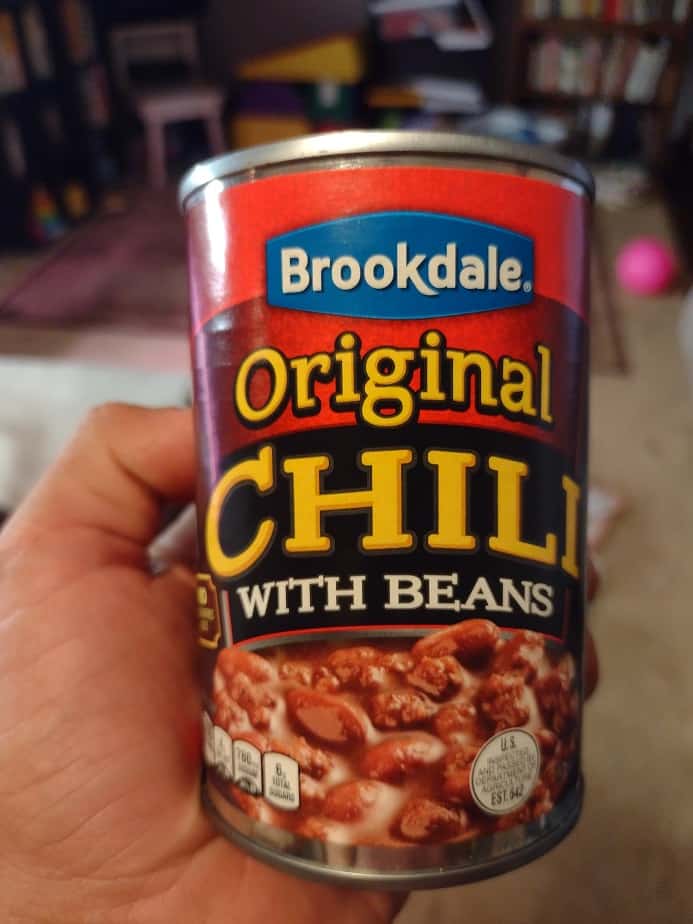
Canned Chilli
Chilli is one of the best value canned foods you can get. Canned foods are a great storage food. canned goods last at least several years, and are edible as long as the can isn’t swollen, leaking, or severely rusted near the sealed edge. I’ve eaten 10-year-old canned chili and it was alright after heating up.
I prefer chili with beans because from what I’ve seen, it usually has the same protein and about the same calories as all meat chili, but at a lower cost. Canned chili with beans makes a complete meal with good fiber and better vitamins. It also tastes alright.

A cheap brand 15-oz can of chili with beans costs around $1.50, which is the cheapest, most nutrition-packed canned food I know of. Most cheap brands are 400-500 calories, 22 grams of protein, a decent amount of fat, and makes a light but high protein meal.
If you are thinking or storing canned goods, remember that they are heavy and take up more space than dry foods, but they are ready to eat and are full of water. Some people recommend buying cans with those easy open tabs, but those ones have a more delicate seal.
You’ll either want can openers with your food stores or cans with the pull tabs. I have a mix of both. Pull tab cans will be fine if they’re not roughed up.

Canned Ham
I recently bought some off-brand canned ham. It’s pretty tasty, low fat, and full of protein and sodium. I’m keeping them in my get-home bag in the car. If it wasn’t cheap, I would have bought it. But at the price, it was one of the best value high-protein canned options in the store. I buy mainly off-brand everything.
A 1-pound canned ham costs about 3 dollars at Wal-Mart. That’s 800 calories, 90 grams of protein, and twice the recommended amount of sodium, good for a sweaty day.
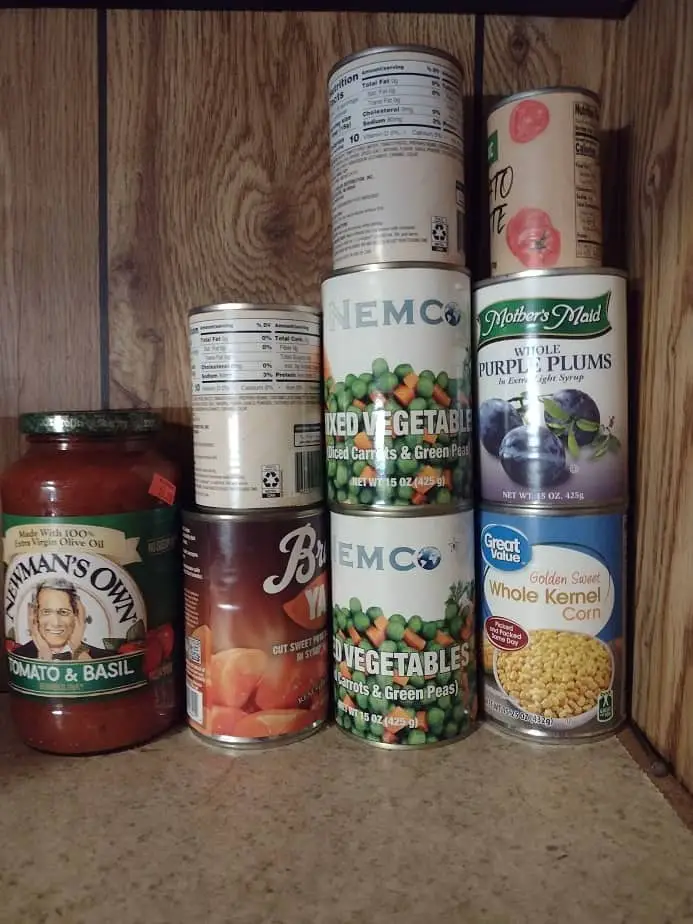
Canned vegetables
You should have some veggies, either canned or dried. Vegetables work to even out your diet and to keep your digestion going well. Unfortunately, canned veggies have been pressure cooked, which greatly lowers the vitamin content in most cases.
I like canned potatoes and canned olives honestly because they have decent amounts of calories. Potatoes are mostly starch with some fiber and protein, and olives have similar calories, but oil instead of protein.
Canned beans are good, cheap, and hearty; although almost not a vegetable. Yams are another good one. They’re fairly cheap and very high in calories, mostly because they tend to come with corn syrup added.
Canned greens have the highest vitamin content out of all the canned vegetables. That’s mustard greens, collard greens, turnip greens, and such. Greens start out a lot higher in the first place.
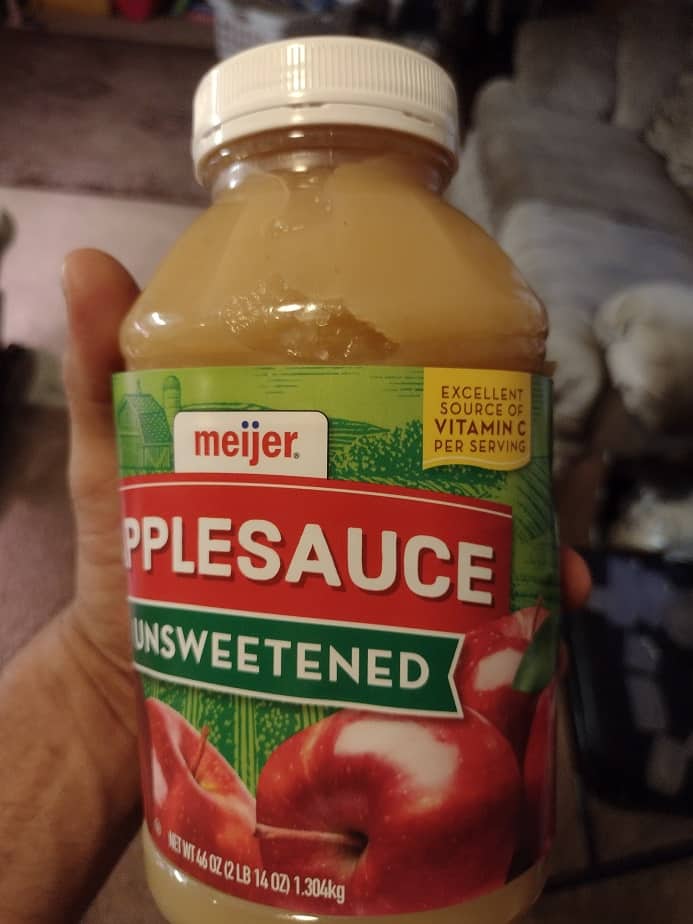
Canned fruits
Canned fruits are delicious, and will last a very long time. They are usually high in calories because of added sugar or corn syrup. The problem is, there’s not much else. It’s been cooked at high temperatures which destroys a lot of its vitamin content. Still, it’s so tasty that I think it’s worth it if you have the room.
Powdered or Dry Milk
Powdered milk tastes weird, but is a powerhouse of calories and protein, as well as vitamin D, vitamin A, calcium, and potassium. It’s freeze-dried fat-free milk. A 5-gallon bucket of powdered milk has more calories and protein than any other dry food you can fill it with. It’s not very cheap though.
When I was young, we used a lot of powdered milk because it was cheaper than regular milk. Now it costs a bit over $4 per gallon’s worth of powdered milk. Powdered milk is one of the better things you can include in your long-term food storage options.
Most of our bulk stored foods are stored in sealed 4-gallon square buckets in the storage room.
Related Articles

